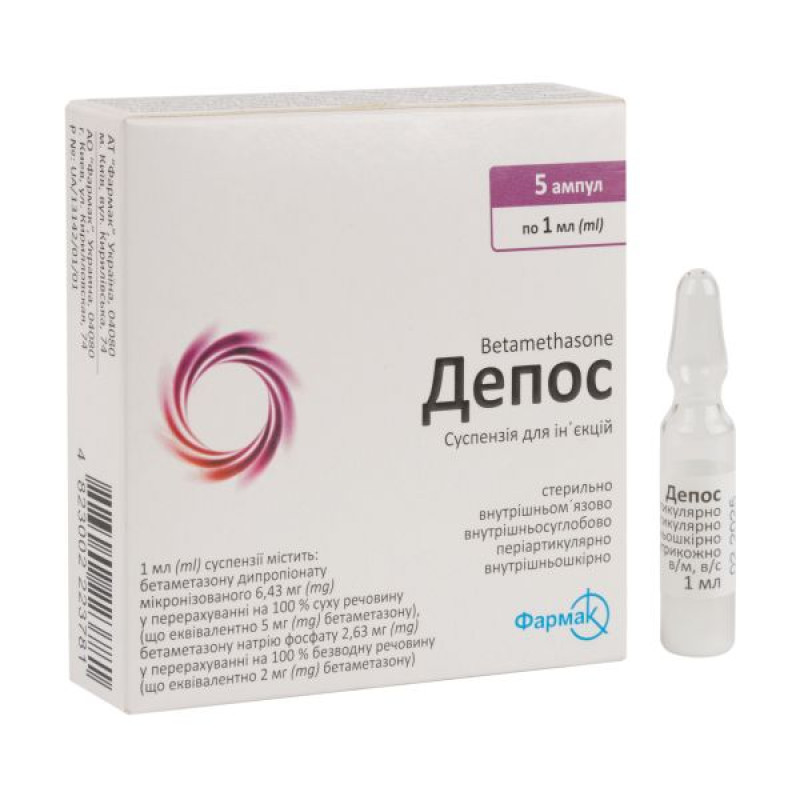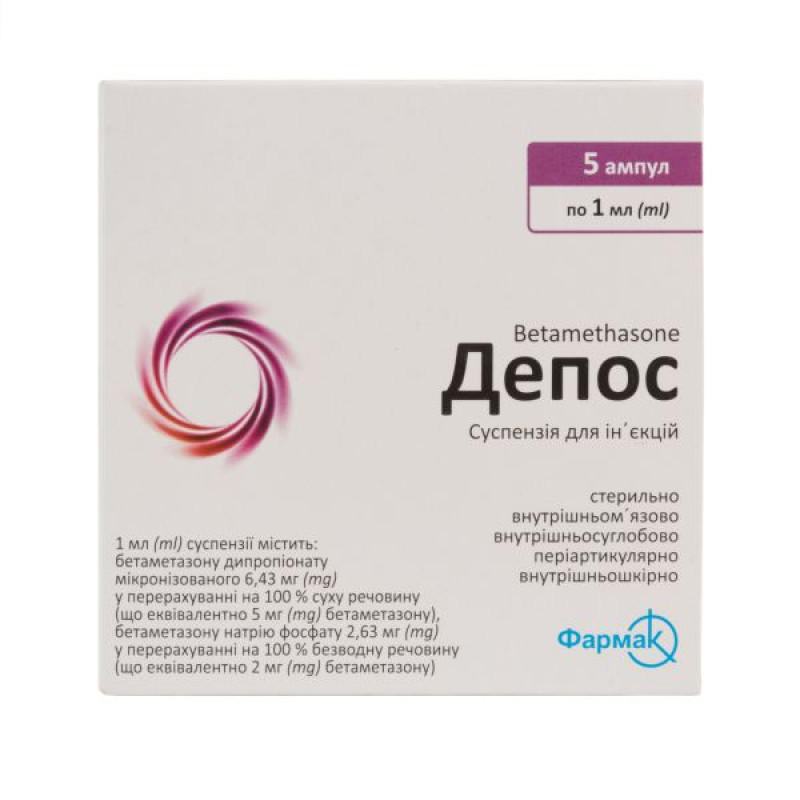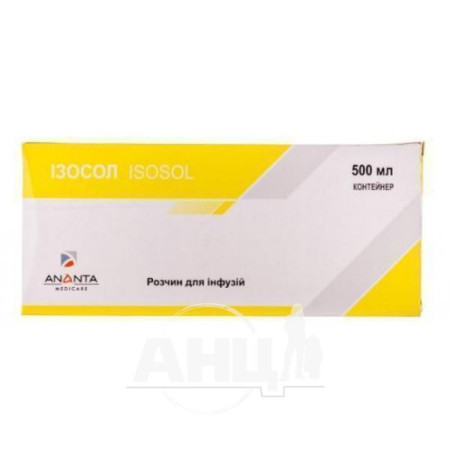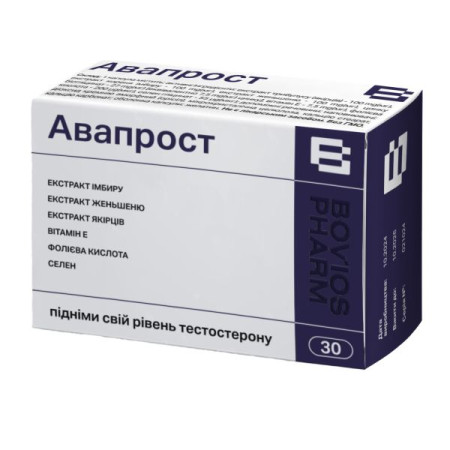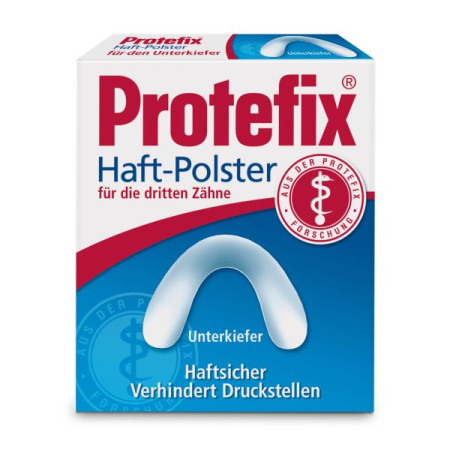Depos suspension for injection 0.7% ampoule 1 ml No. 5

Instructions Depos suspension for injection 0.7% ampoule 1 ml No. 5
Composition
active ingredient: betamethasone;
1 ml of suspension contains 6.43 mg of micronized betamethasone dipropionate in terms of 100% dry matter (equivalent to 5 mg of betamethasone), 2.63 mg of betamethasone sodium phosphate in terms of 100% anhydrous matter (equivalent to 2 mg of betamethasone);
Excipients: methylparaben (E 218), propylparaben (E 216), benzyl alcohol, sodium chloride, sodium hydrogen phosphate anhydrous, disodium edetate, sodium carboxymethylcellulose, polysorbate 80, polyethylene glycol 4000, water for injections.
Dosage form
Suspension for injection.
Main physicochemical properties: clear, colorless or yellowish, slightly viscous liquid containing white or almost white particles that are easily suspended.
Pharmacotherapeutic group
Corticosteroids for systemic use.
ATX code H02A B01.
Pharmacological properties
Pharmacodynamics.
Depot is a combination of soluble and sparingly soluble betamethasone esters for intramuscular, intraarticular, periarticular, intrasynovial and intradermal injections, as well as for administration directly to the lesion. Depot has high glucocorticosteroid activity and insignificant mineralocorticosteroid activity.
Betamethasone has a strong anti-inflammatory, anti-allergic and immunosuppressive effect.
Glucocorticosteroids diffuse across cell membranes and form complexes with specific cytoplasmic receptors. These complexes then enter the cell nucleus, bind to DNA (chromatin) and stimulate the transcription of messenger RNA and the subsequent protein synthesis of various enzymes. These enzymes will ultimately be responsible for the actions observed with systemic use of glucocorticoids. In addition to their significant effects on inflammatory and immune processes, glucocorticoids also affect carbohydrate, protein and lipid metabolism, the cardiovascular system, skeletal muscle and the central nervous system.
Effect on inflammatory and immune processes.
It is the anti-inflammatory, immunosuppressive and antiallergic properties of glucocorticoids that underlie their use in therapeutic practice. The main aspects of these properties are as follows: reduction of immunoactive cells at the level of the inflammatory focus, reduction of vasodilation, stabilization of lysosomal membranes, inhibition of phagocytosis, reduction of the production of prostaglandins and related compounds.
The anti-inflammatory effect is approximately 25 times greater than that of hydrocortisone and 8-10 times greater than that of prednisolone (by weight).
Effect on carbohydrate and protein metabolism.
Glucocorticoids stimulate protein catabolism. In the liver, the released amino acids are converted to glucose and glycogen through the process of gluconeogenesis. Glucose absorption into peripheral tissues is reduced, leading to hyperglycemia and glycosuria, particularly in patients with a predisposition to diabetes.
Effect on lipid metabolism.
Glucocorticoids have a lipolytic effect. This lipolysis is more pronounced at the level of the extremities. In addition, they promote lipogenesis, which is manifested, in particular, at the level of the trunk, neck and head. The complex of actions of glucocorticoids is expressed through the redistribution of fat deposits.
The maximum pharmacological effect of corticosteroids appears later than the peaks in blood serum, which indicates that the main effect of these drugs is not a direct pharmacological action, but rather a modification of enzyme activity.
Pharmacokinetics.
Betamethasone sodium phosphate is a readily soluble component that is rapidly absorbed from the injection site, providing a rapid onset of therapeutic action.
Micronized betamethasone dipropionate is a poorly soluble component that is slowly absorbed from the depot formed at the injection site, and provides a long-lasting effect of the drug.
| Blood concentration | Intramuscular injection | |
| betamethasone | ||
| sodium phosphate | dipropionate micronized | |
Maximum plasma concentration Plasma half-life after a single dose Excretion Biological half-life | 1 hour after taking From 3 to 5 hours 24 hours 36-54 hours | Slow absorption Progressive metabolization More than 10 days |
Plasma protein binding is 62.5%. Metabolized in the liver. Excreted mainly by the kidneys, a small part is eliminated with bile.
Indication
Dermatological diseases
Atopic dermatitis (coin-shaped eczema), neurodermatitis, contact dermatitis, severe solar dermatitis, urticaria, lichen planus, insulin lipodystrophy, alopecia areata, discoid lupus erythematosus, psoriasis, keloid scars, pemphigus vulgaris, herpetic dermatitis, cystic acne.
Rheumatoid arthritis, osteoarthritis, bursitis, tendosynovitis, tendonitis, peritendinitis, ankylosing spondylitis, epicondylitis, radiculitis, coccydynia, sciatica, lumbago, torticollis, ganglion cyst, exostosis, fasciitis, acute gouty arthritis, synovial cysts, Morton's disease, cuboid inflammation, foot diseases, bursitis on the background of a hard corn, spurs, stiffness of the big toe.
Allergic conditions
Bronchial asthma, asthmatic status, hay fever, severe allergic bronchitis, seasonal and aperiodic allergic rhinitis, angioedema, contact dermatitis, atopic dermatitis, serum sickness, hypersensitivity reactions to medications or insect bites.
Collagen diseases
Systemic lupus erythematosus, scleroderma, dermatomyositis, periarteritis nodosa.
Oncological diseases
Palliative therapy of leukemia and lymphoma in adults; acute leukemia in children.
Other diseases
Adrenogenital syndrome. Ulcerative colitis, Crohn's disease, sprue. Pathological changes in the blood that require corticosteroid therapy. Nephritis, nephrotic syndrome.
Primary and secondary adrenal insufficiency (with mandatory simultaneous administration of mineralocorticoids).
Contraindication
Hypersensitivity to betamethasone, other components of the drug or to other glucocorticosteroids. Systemic mycoses. Intramuscular administration in patients with idiopathic thrombocytopenic purpura.
Interaction with other medicinal products and other types of interactions
Concomitant administration of phenobarbital, rifampicin, phenytoin, or ephedrine may increase the metabolism of the drug, thereby reducing its therapeutic activity.
Patients receiving glucocorticosteroid therapy should not be vaccinated against smallpox. Other immunizations should not be given to patients receiving corticosteroids (especially in high doses) due to the risk of neurological complications and low immune response (lack of antibody formation). Immunization is possible in cases of replacement therapy (e.g., Addison's disease).
Combination with diuretics such as thiazides may increase the risk of glucose intolerance.
With the simultaneous use of glucocorticosteroids and estrogens, dose adjustment of the drug may be required (due to the risk of overdose).
Concomitant use of Depo-C with potassium-sparing diuretics increases the risk of hypokalemia. Concomitant use of glucocorticosteroids and cardiac glycosides increases the risk of arrhythmia or digitalis toxicity (due to hypokalemia). Depo-C may potentiate the potassium loss caused by amphotericin B. Serum electrolytes, particularly serum potassium, should be closely monitored in all patients receiving one of these drug combinations.
Simultaneous administration of Depo-C and indirect anticoagulants may lead to changes in blood clotting rate, which requires dose adjustment.
With the combined use of glucocorticosteroids with nonsteroidal anti-inflammatory drugs or ethanol and ethanol-containing drugs, an increase in the frequency or intensity of erosive-ulcerative lesions of the gastrointestinal tract is possible.
When used concomitantly with glucocorticosteroids, salicylates may decrease plasma concentrations. When corticosteroid dosage is reduced or treatment is discontinued, patients should be observed for possible salicylic acid poisoning. The combination of corticosteroids with salicylates may increase the frequency and severity of gastrointestinal ulcers.
For patients with diabetes, it is sometimes necessary to adapt the dosage of oral antidiabetic drugs or insulin, taking into account the hyperglycemic potential of corticosteroids.
The simultaneous administration of glucocorticosteroids and somatotropin may lead to a slowdown in the absorption of the latter. Betamethasone doses exceeding 300-450 mcg (0.3-0.45 mg) per 1 m2 of body surface area per day should be avoided during the use of somatotropin.
Interaction with laboratory tests.
Corticosteroids may interfere with the nitroblue tetrazolium recovery test and give false negative results.
When a patient is undergoing treatment with corticosteroids, this should also be taken into account when interpreting biological parameters and tests (skin tests, thyroid hormone levels, etc.).
Application features
Serious neurological events, some of which were fatal, have been reported following epidural corticosteroid injections. Other events have included reports of spinal cord infarction, paraplegia, quadriplegia, cortical blindness, and stroke. These serious neurological events have occurred with and without fluoroscopy. Because the safety and efficacy of epidural administration have not been established, corticosteroids are not recommended for epidural use.
Depo suspension is not intended for intravenous or subcutaneous administration.
Strict adherence to asepsis rules is mandatory when using the drug.
Abrupt withdrawal or reduction of the dose during continuous use (in the case of very high doses, after a short period of use) or when the need for corticosteroids increases (due to stress: infection, trauma, surgery) may increase the adrenal insufficiency. In this case, the dose should be gradually reduced. In the case of stress, it is sometimes necessary to take corticosteroids again or increase the dose. The dose should be reduced under strict medical supervision, and it is sometimes necessary to monitor the patient's condition for up to one year after stopping long-term treatment or using increased doses.
Rare cases of anaphylactoid reactions have been observed in patients receiving parenteral corticosteroids; therefore, appropriate precautions should be taken before administering the drug, particularly if the patient has a history of allergy to one of the components of the drug.
With prolonged corticosteroid therapy, a switch from parenteral to oral administration should be considered after assessing the potential benefits and risks.
Intramuscular injections of glucocorticosteroids must be administered deep into the muscle to prevent local tissue atrophy.
Intra-articular injections should only be performed by medical personnel. Intra-articular fluid analysis is necessary to exclude septic process. The drug should not be administered in the presence of intra-articular infection. A noticeable increase in pain, swelling, increased temperature of the surrounding tissues and subsequent limitation of joint mobility indicate septic arthritis. When the diagnosis is confirmed, antibacterial therapy should be prescribed. Glucocorticosteroids should not be injected into an unstable joint, infected areas and intervertebral spaces. Repeated injections into the joint in osteoarthritis may increase the risk of joint destruction. Direct injections of corticosteroids into the tendon should be avoided, as small tears may occur later. After successful intra-articular therapy, the patient should avoid overloading the joint.
Administration of a corticosteroid into soft tissue or into the lesion and around the joint may cause systemic and local effects.
Special patient groups
Betamethasone should only be used by diabetics for a short period of time and only under strict medical supervision, given its glucocorticoid properties (transformation of proteins into glucose).
There is an increased effect of glucocorticosteroids in patients with hypothyroidism or cirrhosis of the liver. Depos should be avoided in patients with herpetic eye lesions (due to the possibility of corneal perforation).
Mental disorders are possible when using the drug (especially in patients with emotional instability or a tendency to psychosis).
Precautions are necessary in the following cases: nonspecific ulcerative colitis, threat of perforation, abscess or other pyogenic infections; diverticulitis; intestinal anastomoses; gastric and duodenal ulcers; renal failure; arterial hypertension; osteoporosis; myasthenia gravis; glaucoma; acute psychoses; viral and bacterial infections; growth retardation; tuberculosis; Cushing's syndrome; diabetes; heart failure; in the case of difficult-to-treat epilepsy; predisposition to thromboembolism or thrombophlebitis; during pregnancy.
Patients receiving glucocorticosteroid therapy should not be vaccinated against smallpox. Other immunizations should not be given to patients receiving corticosteroids (especially in high doses) due to the risk of neurological complications and low immune response (lack of antibody formation). Immunization is possible in cases of replacement therapy (e.g., Addison's disease).
Patients, particularly children, receiving Depo-C at immunosuppressive doses should avoid contact with patients with chickenpox and measles.
Corticosteroids may mask some signs of infectious disease. New infections may occur during use due to decreased resistance.
The drug should only be used in active tuberculosis in cases of rapid or disseminated tuberculosis in combination with adequate anti-tuberculosis therapy. If corticosteroids are prescribed to patients with latent tuberculosis or those who respond to tuberculin, special monitoring is necessary, since relapse of the disease is possible. With prolonged therapy with corticosteroids, patients should also receive chemoprophylaxis. If rifampicin is used in a chemoprophylaxis program, it may be necessary to adjust the dosage of corticosteroids due to the fact that rifampicin can enhance the metabolism of the drug.
Moderate and high doses of corticosteroids can cause increased blood pressure, fluid and sodium retention in the tissues, and increased potassium excretion (which may manifest as edema and heart failure). A salt-restricted diet and additional potassium-containing supplements are recommended.
Acetylsalicylic acid should be taken with caution in combination with the drug for hypoprothrombinemia due to the possibility of increased bleeding.
It is also necessary to remember the possibility of developing secondary adrenal insufficiency within several months after the end of therapy.
Pheochromocytoma crisis, including fatal cases, has been reported. Corticosteroids should be administered to patients with known or suspected pheochromocytoma only after appropriate benefit-risk assessment.
When using glucocorticosteroids, changes in sperm motility and number are possible.
This medicinal product contains less than 1 mmol (23 mg) sodium/dose, i.e. essentially sodium-free.
The excipients methylparaben (E 218) and propylparaben (E 216) may cause allergic reactions (possibly delayed) and in some cases bronchospasm.
Use during pregnancy or breastfeeding
Due to the lack of controlled studies on the safety of the drug, pregnant women, breastfeeding women, and women of reproductive age should be prescribed the drug after careful assessment of the benefit to the mother and the potential risk to the fetus/child.
In some cases, it is necessary to continue treatment with corticosteroids during pregnancy or even increase the dosage (for example, in the case of corticosteroid replacement therapy).
Intramuscular administration of betamethasone leads to a significant reduction in the incidence of dyspnea in the fetus if the drug is administered more than 24 hours before delivery (before the 32nd week of pregnancy).
Corticosteroids should not be prescribed to treat hyaline membrane disease after birth.
In the case of prophylactic treatment of hyaline membrane disease in premature infants, corticosteroids should not be administered to pregnant women with preeclampsia and eclampsia or those with placental involvement.
Studies have shown an increased risk of neonatal hypoglycemia after a short antenatal course of betamethasone in women at risk of late preterm birth.
Children born to mothers who received high doses of corticosteroids during pregnancy should be monitored for early signs of adrenal insufficiency.
Corticosteroids penetrate the placental barrier and into breast milk.
Because corticosteroids cross the placenta, newborns and infants whose mothers received corticosteroids during most or part of pregnancy should be carefully examined for possible congenital cataracts.
If it is necessary to prescribe Depo-C during lactation, the issue of stopping breastfeeding should be decided, taking into account the importance of therapy for the mother (due to possible undesirable side effects in children).
Women who have received corticosteroids during pregnancy need to be monitored during labor to detect any adrenal insufficiency due to the stress of childbirth.
Ability to influence reaction speed when driving vehicles or other mechanisms
Depo-C usually does not affect the patient's reaction time when driving or operating other mechanisms.
But in rare cases, muscle weakness, seizures, visual disturbances, dizziness, headache, mood swings, depression (with pronounced psychotic reactions), and increased irritability may occur, so it is recommended to refrain from driving or working with other mechanisms during treatment with the drug.
Method of administration and doses
Depot is recommended to be administered intramuscularly if systemic administration of glucocorticosteroid is necessary; directly into the affected soft tissue or as intraarticular and periarticular injections for arthritis; as intradermal injections for various skin diseases; as local injections into the lesion for some foot diseases.
The dosage regimen and method of administration are determined by the doctor individually, depending on the indications, severity of the disease and the patient's response to treatment. The dose should be minimal, and the period of use should be as short as possible.
The dose should be adjusted to obtain a satisfactory clinical effect. If a satisfactory clinical effect is not observed within a certain period of time, treatment with the drug should be discontinued by progressive dose reduction and other appropriate therapy should be instituted.
In the event of a favorable response, an appropriate dose should be determined and maintained by gradually reducing the initial dose at appropriate intervals until the lowest dose with an adequate clinical response is reached.
Depo suspension is not intended for intravenous or subcutaneous administration.
The initial dose of the drug in most cases is 1-2 ml. The injection is repeated if necessary, depending on the patient's condition. The drug is administered deep intramuscularly into the buttock:
– in severe conditions (lupus erythematosus and asthmatic status) that require emergency measures, the initial dose of the drug may be 2 ml;
– for various dermatological diseases, as a rule, 1 ml of the drug is sufficient;
– in diseases of the respiratory system, the drug begins to act within a few hours after intramuscular injection. In bronchial asthma, hay fever, allergic bronchitis and allergic rhinitis, a significant improvement in the condition is achieved after the administration of 1-2 ml of the drug;
– for acute and chronic bursitis, the dose for intramuscular administration is 1-2 ml of the drug. If necessary, several repeated injections can be performed.
Topical application
The simultaneous use of a local anesthetic is necessary only in rare cases (the injection is practically painless). If simultaneous administration of an anesthetic is desired, then a 1% or 2% solution of procaine hydrochloride or lidocaine, or similar local anesthetics, using dosage forms that do not contain parabens, is used. Anesthetics containing methylparaben, propylparaben, phenol and other similar substances are not allowed. When using an anesthetic in combination with the drug Depos, first draw the required dose of the drug from the vial into the syringe, then draw the required amount of local anesthetic from the ampoule into the same syringe and shake the syringe for a short period of time.
In acute bursitis (subdeltoid, subscapular, ulnar, and anteropopliteal), injection of 1-2 ml of Depoc into the bursa can relieve pain and fully restore mobility within a few hours.
Chronic bursitis should be treated with lower doses of the drug after the acute attack of the disease has subsided.
In acute tendosynovitis, tendinitis and peritendinitis, 1 injection of Depoc relieves the patient's condition, in chronic cases, the injection of the drug should be repeated depending on the reaction. It is necessary to avoid administering the drug directly into the tendon.
In rheumatoid arthritis and osteoarthritis, intra-articular administration of the drug in a dose of 0.5-2 ml reduces pain, tenderness, and stiffness of the joints within 2-4 hours after administration. The duration of the therapeutic effect of the drug varies significantly and can be 4 weeks or more.
Recommended doses of the drug when administered into large joints are 1-2 ml; into medium joints - 0.5-1 ml; into small joints - 0.25-0.5 ml.
In case of dermatological diseases, intradermal administration of the drug directly into the lesion is effective. Inject 0.2 ml/cm2 of Depot into the skin (not under the skin) using a tuberculin syringe and a needle with a diameter of approximately 0.9 mm. The total amount of the drug injected into the injection site should not exceed 1 ml.
In case of corticosteroid-sensitive foot diseases. Bursitis under the corn can be overcome by two consecutive injections of 0.25 ml each. In diseases such as hallux valgus, hallux valgus and acute gouty arthritis, relief can come very quickly.
Recommended single doses of Depoc (with an interval of 1 week between injections): for hard corns – 0.25-0.5 ml; for spurs – 0.5 ml; for stiffness of the big toe – 0.5 ml; for varus little toe – 0.5 ml; for synovial cysts – from 0.25 to 0.5 ml; for tendosynovitis – 0.5 ml; for cuboid inflammation – 0.5 ml; for acute gouty arthritis – from 0.5 to 1 ml. It is recommended to use a tuberculin syringe with a needle with a diameter of approximately 1 mm for administration.
If a stressful situation (not related to the disease) occurs or is threatened, it may be necessary to increase the dose of the drug.
Discontinuation of the drug after long-term therapy should be carried out by gradually reducing the dose. Monitoring of the patient's condition should continue for at least a year after the end of long-term therapy or after the use of the drug in high doses.
Children
There is insufficient clinical data on the use of the drug in children, therefore it is undesirable to use it in patients of this age category (possible growth retardation and development of secondary adrenal insufficiency).
Overdose
Acute overdose of betamethasone does not create life-threatening situations. The administration of high doses of glucocorticosteroids for several days does not lead to undesirable consequences (except in cases of very high doses or in the case of use in diabetes mellitus, glaucoma, exacerbation of erosive-ulcerative lesions of the gastrointestinal tract, in the case of use in patients who are simultaneously undergoing therapy with cardiac glycosides, indirect anticoagulants or potassium-sparing diuretics).
Treatment. Careful medical monitoring of the patient's condition is necessary. It is necessary to maintain optimal fluid intake and monitor the content of electrolytes in plasma and urine (especially the balance of sodium and potassium in the body). If an imbalance of these ions is detected, appropriate therapy should be carried out.
Adverse reactions
Adverse reactions, as with other glucocorticosteroids, are dose- and duration-dependent. These reactions are usually reversible and can be reduced by reducing the dose.
Disturbances of water and electrolyte balance: natriemia, increased potassium excretion, hypokalemic alkalosis, increased calcium excretion, fluid retention in the tissues.
Cardiovascular system: congestive heart failure in patients predisposed to this disease; arterial hypertension.
Musculoskeletal system: muscle weakness, myopathy, loss of muscle mass, worsening of myasthenic symptoms in myasthenia gravis, osteoporosis, sometimes with severe bone pain and spontaneous fractures (compression fractures of the spine), aseptic necrosis of the femoral or humeral heads, pathological fractures of long bones, tendon ruptures, joint instability (after multiple injections).
On the part of the digestive system: hiccups, erosive-ulcerative lesions of the stomach with possible perforation and bleeding, esophageal ulcers, pancreatitis, flatulence, intestinal perforation, nausea, vomiting.
Skin and subcutaneous tissue disorders: impaired wound healing, skin atrophy, thinning and weakening of the skin, petechiae and ecchymoses, bruising, facial erythema, increased sweating, skin reactions such as allergic dermatitis, urticaria, angioedema.
Nervous system: convulsions, increased intracranial pressure with swelling of the optic disc (pseudoedema of the brain) usually after completion of treatment, dizziness, headache, migraine, euphoria, mood changes, personality changes and severe depression, increased irritability, insomnia, psychotic reactions, particularly in patients with a psychiatric history, depression.
Endocrine disorders: menstrual irregularities, clinical symptoms of Cushing's syndrome, fetal or child growth retardation, impaired carbohydrate tolerance, manifestations of latent diabetes mellitus, increased need for insulin injections or oral antidiabetic agents for patients with diabetes.
On the part of the organs of vision: posterior subcapsular cataract, increased intraocular pressure, glaucoma, exophthalmos.
Metabolic disorders: negative nitrogen balance due to protein catabolism; lipomatosis, including mediastinal and epidural lipomatosis, which may lead to neurological complications; weight gain.
Immune system: Corticosteroids may cause suppression of skin tests, mask symptoms of infection and activate latent infections, and reduce resistance to infections, particularly mycobacteria, Candida albicans, and viruses.
From the lymphatic system: anaphylactic reaction or hypersensitivity reaction to the administration of the drug and hypotensive reaction.
General disorders and administration site conditions: isolated cases of blindness following topical administration to the face and scalp, hyper- or hypopigmentation, subcutaneous and cutaneous atrophy, aseptic abscesses, post-injection exacerbation (intra-articular administration) and Charcot arthropathy. Secondary pituitary and adrenal suppression in the event of stress (trauma, surgery or illness).
After repeated intra-articular injection, joint damage is possible. There is a risk of infection.
Expiration date
2 years.
Do not use the drug after the expiration date indicated on the package.
Storage conditions
Store in the original packaging at a temperature not exceeding 25 ° C. Do not freeze.
Keep out of reach of children.
Incompatibility
The drug can be mixed in the same syringe with local anesthetics (see section "Method of administration and dosage"); however, compatibility must always be monitored.
Packaging
1 ml in an ampoule. 1 or 5 ampoules in a blister. 1 blister in a pack. 1 ml in a pre-filled syringe. 1 pre-filled syringe complete with 2 needles in a blister. 1 blister in a pack.
Vacation category
According to the recipe.
Producer
JSC "Farmak".
Location of the manufacturer and its business address
Ukraine, 04080, Kyiv, Kyrylivska St., 74.
There are no reviews for this product.
There are no reviews for this product, be the first to leave your review.
No questions about this product, be the first and ask your question.




